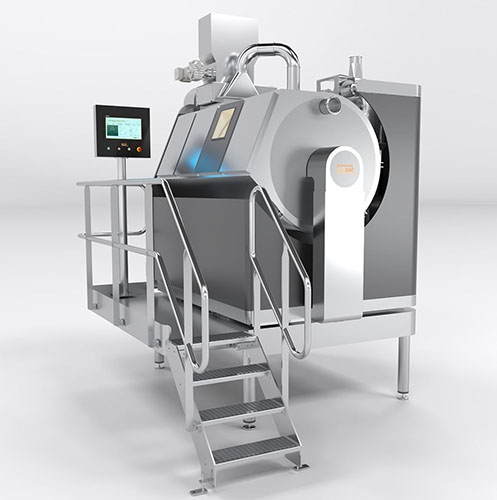
Verhoeven Bakery Equipment Family developed the Repeatloaf initiative to contribute to lowering waste in the baking industry. It offers an automated solution that upcycles leftover bread.
Bread supply is facing multiple challenges and could potentially see severe shortages in the coming years, with a growing world population and an increased demand for bread, especially in emerging markets.
Bread is often at the top of many lists of food waste contributors, especially volume-wise. Overproduction, its short shelf-life and the need to have the staple product always available are among the main causes for this.
The problem becomes even more complex when looking at the emissions released to produce bread. According to The International Journal of Life Cycle Assessment, carbon footprint results range from 977 to 1,244g CO2 eq. for a single loaf of bread. Before bread production even begins, growing 1 kg of wheat requires between 900 and 2,000 liters of water (FAO). Energy is then needed to transport the wheat to mills, grind the grains and transport the flour to bakeries. An estimated 64% of the greenhouse gas emissions associated with bread production have already occurred before the flour even enters the bakery. This can be avoided by reusing leftover bread.
‘Give Loaf a Second Chance’
With the Repeatloaf concept, an optimized automatic process has been created, which builds on the initiative of the Dutch ‘Bakkersgrondstof’. It meets the need to reduce the enormous amount of bread thrown away. According to figures from the European Community, the equivalent of 15% of the total European bread production is not consumed. This is equivalent to a waste of 15 billion kg of bread per year. By processing leftover bread into a fermented bread ingredient that has a shelf life of months, not only is it recycled, but in fact upcycled, a creative translation of waste into an improved new product. The ‘Repeatloaf precision fermented powder’ therefore gives a second chance to bread that would otherwise be thrown away. The slogan ‘Give Loaf a Second Chance’ makes it even more beautiful: it means real love for the second life of bread.

”We can now offer a one-day process that allows the user to calculate their capacity requirements easily – they are equal to their daily loss.”
René van Ass, Business Development Officer, Verhoeven
The RepeatLoaf concept
Verhoeven Bakery Equipment Family has been focusing on two aspects in its R&D in its search for a solution to this issue: innovation and sustainability. The company developed an automated solution that makes a fermented powder with an increased shelf-life, out of leftover bread. The fermentation process takes less than 24 hours, and the fermented powder is suitable for use as an alternative to flour, as decoration, or to enrich the flavor of baked products.
The company’s sustainability focus is at the heart of the project that led to the Repeatloaf solution: “The Sustainable Development Goal 12.3 is very specific: a 50% reduction in food waste by 2030. As bread still tops the list of food waste, initiatives to reduce it contribute to a sustainable future. The Repeatloaf initiative is new and unique in this field; it creates a dry powder that can be easily preserved and used to re-create dough from bread waste,” Verhoeven outlines.
In the development stages, the original concept was based on a manual fermentation process that took roughly four days. Verhoeven set out to shorten this time and optimize the results, while also improving and automating the process.
“Processing time influences the capacity that can be processed. We can now offer a one-day process that allows the user to calculate their capacity requirements easily – they are equal to their daily loss,” explains René van Ass, Business Development Coach, Verhoeven.
The company identified three streams of waste, out of which, the internal streams are the first tackle in this project. In the production process, around 10-15 % of the bread is lost, according to research from the World Resources Institute. “Repeatloaf is the solution for that! External streams bring extra challenges, which are also the subject of an ongoing study. The recycling process can be mastered once the products to be recycled are identified,” he reveals. There are several products that can be recycled simultaneously. Most types of bread can run through the machine in a mix. However, products containing ingredients such as raisins, seeds and nuts can influence the resulting powder, which is why Verhoeven recommends avoiding them. “The input influences the output,” Verhoeven notes.
There are several opportunities to use the resulting powder; as it undergoes a fermentation process, it can bring taste and even volume improvements when added into the production of new bread at the right dosage. It can also make for a good decoration material.
The machine is compact, designed to save space, and its installation is a straightforward, plug-and-play process. Verhoeven can assist bakeries in setting up the process, based on the products that will be used: “Together with the user, input quality and quantities are determined to form the basis for a preset menu, which is calculated to steer the fermentation process,” the specialist explains.
The fermented powder has no special requirements other than flour for storage and can be deposited for later use at ambient temperature and humidity, in a closed container.
In addition to efforts to reduce energy consumption and emissions while baking, the Repeatloaf brings one more solution to increase sustainability in the bakery. It’s a promising field.


